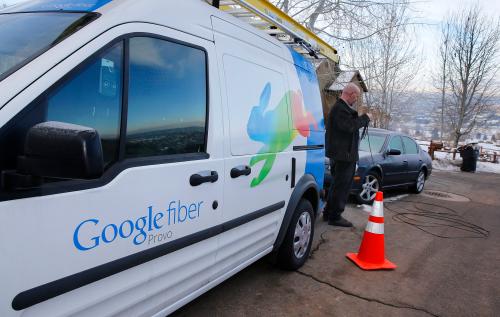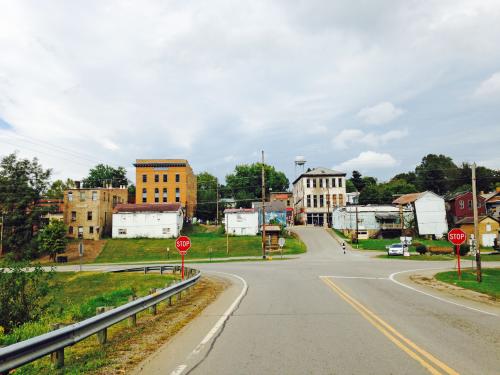This article is part of the Brookings Metropolitan Infrastructure Initiative’s “Digital Prosperity” blog series, which examines how regions across the country are using innovative strategies to respond to a range of digital inclusion challenges.
All too often, America’s broadband internet gaps mirror its racial gaps. Put most plainly, Black households and neighborhoods adopt broadband at a lower rate than their white peers. While all but 10% of white households have an in-home broadband subscription, 18% of Black households do not. Given the health and equity benefits we know that broadband can deliver to people and communities, this disparity is unacceptable.
Cities and states with racial disparities in health and economic status face a choice: Let broadband become just another marker of racial inequity, or make the choice to support and empower communities of color through equal access to affordable broadband and the digital skills to use it.
Cleveland is one city where civic leaders and local activists are working to close the race-based digital divide through a mix of innovative solutions and institutional advocacy. The challenges that they’ve faced and the successes they’ve earned provide lessons for any region up against similar barriers to equitable broadband adoption.
The city of Cleveland and the metropolitan area it anchors have a long history of racial exclusion and segregation. To this day, it remains racially segregated, with most of the Black population clustered in the eastern side; compared to the rest of the country’s 100 largest metro areas, Cleveland ranks 98th in racial inclusion, with massive gaps in earnings, poverty, and employment.
Broadband adoption is no exception to the region’s list of racial inequities. While the average broadband adoption rate for households in Cleveland’s majority-white neighborhoods is 81.2%, the average is just 63% in Black-majority neighborhoods, based on 2018 American Community Survey 5-year data. Broadband adoption is both a lagging and leading indicator of economic growth and prosperity, meaning these numbers are a sign of the existing economic inequities in Black communities as well as the barriers to greater prosperity in the future.

The challenges in closing Cleveland’s broadband adoption gap are systemic and multitiered. A 2017 study by Connect Your Community and the National Digital Inclusion Alliance found that AT&T systematically discriminated against low-income Cleveland neighborhoods in its deployment of home internet services. This “digital redlining” mirrors the early 20th century’s discriminatory housing practice that, to this day, disenfranchises minority and immigrant neighborhoods.
These geographic and race-based barriers to the digital economy are a drag on the entire region, not just the most impacted neighborhoods. Fortunately, Cleveland’s civic community is developing creative responses to begin closing the digital divide.
DigitalC, a Cleveland nonprofit that offers discounted high-speed services to underserved neighborhoods, is a powerful example of how to run a multitiered strategy. Their partnership with the Cuyahoga Metropolitan Housing Authority delivers wholesale broadband support to more than 550 households. DigitalC also runs digital skills training programs aimed at veterans, former prisoners, and school-aged kids, among other populations.
The Ashbury Senior Computer Community Center (ASC3) also offers digital skills development programs, guided by the belief that the best way to build those skills is to meet people where they are. For the past 15 years, ASC3 has offered free computer courses, with a focus on older individuals from four predominantly Black neighborhoods. Even after losing significant funding when the federal government eliminated direct support to local digital skills programs in 2012, ASC3 has still trained 2,000 people over the past four years. In 2019, they received a significant grant from the Cleveland Foundation to scale up their efforts.
Cleveland also offers an important test bed for the intersection between broadband and health. The regional MetroHealth medical system and researchers at Case Western Reserve University have begun to explore how broadband adoption rates may impact health outcomes, including what is a clear gap in medical research: how to increase use and quantify the benefits of electronic health records and other digital health systems. Early results, including work conducted with ASC3, suggest that sustained digital skills development can improve health outcomes through stronger engagement between health providers and patients. Still, regional digital records systems are not paired with programs to ensure patients have the digital skills or in-home broadband necessary to access digital health resources. These health interventions are particularly important for Cleveland’s Black communities, who face higher rates of asthma, diabetes, and high blood pressure, as well as lower life expectancies.
These interventions offer a starting point for addressing disparate racial outcomes not only in Cleveland, but nationwide. DigitalC shows that a nonprofit can provide disenfranchised communities with an affordable broadband alternative to traditional service providers. ASC3 shows that—with consistent support—it’s possible to provide effective digital skills training at scale. And MetroHealth serves as an example of a legacy institution whose mission is furthered by investments in digital capacity and education. Banks, philanthropies, hospitals, and other vital institutions in Cleveland and across the country should follow suit.
The legacies of Cleveland’s racial discrimination will not be easily erased. But a commitment by civic actors both in and outside of the digital equity space will go a long way in beginning to lift those communities up again.
The Brookings Institution is committed to quality, independence, and impact.
We are supported by a diverse array of funders. In line with our values and policies, each Brookings publication represents the sole views of its author(s).







Commentary
How Cleveland is bridging both digital and racial divides
March 9, 2020